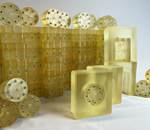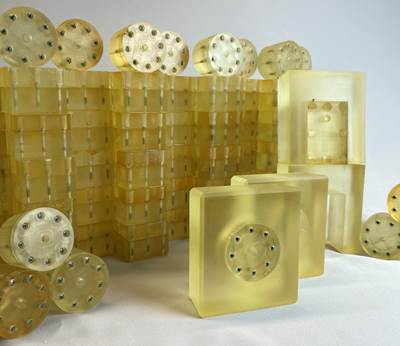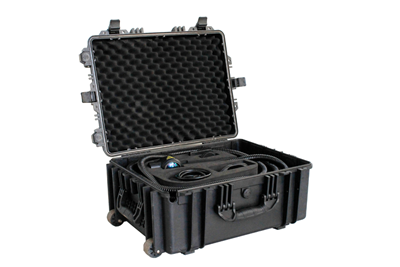3D Printing Accelerates R&D Process For Prototyping Molds
Utilizing Axtra3D’s additive technology, LSI Solutions, a medical equipment manufacturer found the compatible machine it needed to accelerate its R&D process for prototyping molds for medical devices.
LSI Solutions, a medical equipment manufacturer based in upstate New York, utilized Axtra3D Inc.’s additive manufacturing (AM) technology to create molds for medical device prototyping and production.
Image depicts Axtra3D’s technology, the Lumia X1, being prepared for a mold build. Source (All images) | LSI Solutions
The collaboration between LSI Solutions and Axtra3D came about when LSI Solutions began searching for an avenue to accelerate its R&D cycle. A typical prototype mold takes three to seven days for the company to machine out of steel. If it’s a more time-consuming prototype mold, it could take as long as 14 days. Deep ribs and small details require small cutters that are often difficult to machine. However, 3D printing offers an accelerated path for prototyping molds.
Specifically, LSI Solutions wanted to find the right 3D printing technology to pair with a specific material grade, Ultracur3D RG 3280, from the chemical solutions company, Forward AM. LSI Solutions opts for this material as it is ideal for intricate molds for medical devices.
This material grade offers good surface finishes regarding overall smoothness, a fast build speed relative to other materials (as much as 10 times faster than alternatives) and clean edges once parts come off the printer. Additionally, the material offers compressive strength, maintains durability at relatively high temperatures and enables complex designs.
Initially, LSI Solutions experimented with desktop printers to prove the concept of using Forward AM’s material grade for mold prototyping, but due to the materials’ extreme strength and rigidity, it destroyed these printers.
Enter Axtra3D’s printer for injection molding.
Practice Makes Perfect
According to LSI Solutions’ Molding Manager, Evan Sutorius, “The company does a lot of prototyping and functions as an R&D company at its core.” LSI Solutions makes all of its molds in-house and as such, has six full-time moldmakers, two mold designers, two mold operators and five mold technicians dedicated to this purpose.

Mold for a medical device is shown being printed on the Lumia X1.
The company prototypes various devices for minimally invasive procedures. These molds are geometrically complex, leaving little room for error. The devices tend to be small, with intricate details. Most have to fit through an incision of an inch or even half an inch to put this into perspective.
Due to this complexity, Sutorius says that back in 2017, the company got serious about moldmaking, updating its shop floor with all new equipment from Makino. Prior to this, the company was using commodity production equipment to try to build molds.
“This wasn’t super mold-specific or sustainable, so in 2017, we made a proper commitment to moldmaking,” says Sutorius. The first step was to add three Makino mills, a sinker EDM machine and two wire EDM machines. This enabled the company to enter the fold of moldmaking capabilities, specifically for hard milling and in-house molding.
To continue ramping up its R&D process, LSI Solutions began exploring a method for generating prototype molds via 3D printing with an all-in-one, compatible solution in terms of technology, material and geometric capabilities.
“We wanted to find a way to 3D print molds where we didn’t have to make a lot of concessions when it came to part design,” says Sutorius.

An LSI Solutions team member removes the completed mold from the build plate with ease.
Ideally, if everything goes right, molds should be able to outlast their application, meaning the molds can be used for the low-volume production runs the company needs them for. According to Sutorius, this usually means anywhere between 25-85 parts.
So, the company began experimenting with the Ultracur3D RG 3280 material grade from Forward AM. The properties of this material proved to be a good match for the company’s specific molding needs for surface finish (no layer lines, aesthetically and geometrically cleaner and with less postprocessing needed), but finding the right 3D printer proved difficult.
While testing the material grade on desktop printers, its strength, rigidity and sheer force cracked the screens of these printers, as well as the membranes that serve as part of the screens. The printer would physically flex when building with this material. Molds got stuck on the build plate after the print was complete, thus risking getting damaged once removed. Additionally, the parts had bad layer lines when they would come off the printer, which made releasing parts out of a mold extremely difficult or in some cases impossible.
After experimenting with the desktop printers, LSI Solutions was equipped with this trial-and-error based information, LSI Solutions knew it needed a stronger machine to support the material moving forward. One that would ultimately accelerate its R&D process without compromising time, geometric capabilities or surface finish.
Finding a Compatible Technology
The company connected with Axtra3D for a solution. Founded in 2021, Axtra3D specializes in developing advanced additive manufacturing solutions.
The 3D injection mold printer, called the Lumia X1, offers a variety of benefits that LSI Solutions was searching for, including:
- Industrial-grade strength in terms of durability and ability to withstand more extreme conditions (the hard ceramic-filled material, for example).
- Hybrid PhotoSynthesis (HPS) technology that integrates a laser and a Digital Light Processing (DLP) system to simultaneously image internal and external structures. The DLP handles large areas for high throughput, while the laser focuses on intricate details and external walls, ensuring high resolution. This dual approach enables the Lumia X1 to produce detailed parts quickly and efficiently.
- TruLayer Separation, ensures seamless layer transitions by rapidly detaching the active print layer and moving to the next one. It eliminates the hydrostatic forces typically associated with layer separation in DLP and LCD printers, reducing wait times and enabling the printing of large and complex parts with a glass-like surface finish directly from the machine.
- TruLayer Adaption offers flatness of the glass plate for each layer, This feature dynamically adjusts the plate to maintain the precise resin thickness required. Unlike fixed glass plates in other printers, this dynamic adjustment prevents the need for prolonged curing times and guarantees consistency across the entire platform, regardless of layer height.
- Small eco-footprint, ideal for conserving shop floor space.
“We use the Axtra3D Lumia X1 daily and it has become a critical tool in our arsenal,” says Benjamin Boseck, LSI Solutions’ discovery manager.
This technology affords fast turnaround time for mold inserts, as it offers two build plates per printer and LSI Solutions just bought a third build plate for other applications. When you remove one build plate with molds, you can quickly pop another back in, saving time. Since printing with the Axtra3D printer in mid-July, LSI Solutions has produced 70-75 molds.
The Lumia X1 also affords quality surface finishes with a smooth, satin-like matte finish on molds. This means no layer lines and offers customers a more cosmetic appeal. Additionally, the 3D printer offers LSI Solutions a less conservative approach to moldmaking. The team can take more risks without fear of ruining a project timeline or design. Using the printer, molds can be created in far less time than traditional methods, leaving more room for iterating if need be.
Compatibility Results in R&D Acceleration
LSI Solutions has sped up its R&D process and reduced costs by using its Lumia X1 to print prototype molds in Forward AM’s material to produce medical parts.
According to Sutorius, a typical prototype mold takes between three to seven days for LSI Solutions to machine out of steel. If it’s a more time-consuming prototype mold, it could take as long as 14 days.
A 3D printed mold typically takes between 30 minutes and 10 hours to print. Afterward, the team spends about 60-90 minutes on postprocessing, which includes cleaning off excess resin from the mold and build plate, a post-cure of the mold, coating the mold and prepping the machine for the next build. The 3D printer prints at the same speed regardless of mold geometry, so deep ribs and small details do not slow it down. The resin cost is in the ballpark of $2.25 a cubic inch, so most of the molds the company produces are under $75 in resin and a large mold would be in the $500 range. This helps keep cost down while producing fast, quality molds.
“Axtra3D was very easy to work with in terms of getting samples, assisting with the equipment set up and troubleshooting,” says Sutorius. Regarding the training process, two team members from Axtra3D came to LSI Solutions for about a week this past summer to set up the machine. Axtra3D ensured everything was leveled, calibrated and ready to print. By the second day, the machine was up and running. Six LSI Solutions employees underwent the training.
As of now, two employees are in charge of the technology programming and two employees focus on technician duties, such as removing parts, cleaning, postprocessing, etc.
“Right now, the shop is very busy making production molds and our prototyping window is often short, so the Lumia X1 becomes invaluable,” says Sutorius.
“Our Axtra3D’s printer takes the pressure off of our moldmakers, as it can handle waves of production molds, freeing up the moldmakers and designers to take on more challenging design projects,” adds Sutorius.
At LSI Solutions, the R&D process is constantly in demand of new technology to facilitate effective prototypes. The ability to design a part, design a mold, 3D print the mold and have parts in hand that represent the final material in days (or even hours sometimes) is huge for development and Axtra3D’s Lumia X1 makes this all possible.
Related Content
Material Choice Considerations for Mold Venting
A comparison of high-tonnage pressed steel—such as H13, 420 stainless, P20 and pressed porous venting mold steel—and 3D printed tooling.
Read MoreHow to Expand the Use of Aluminum Injection Molds
Six factors to consider to broaden the application of aluminum molds.
Read MoreMoldMaking Technology's Hottest Tips of 2023
The staff at MoldMaking Technology prides ourselves on bringing you the most helpful, relevant tips in the industry. Here are the top five most-viewed tips of 2023 based on Google Analytics.
Read More2024 Most-Viewed Products
A comprehensive dive into 2024’s most-viewed products, as revealed through MMT's analytics. This review highlights the most popular products, ranging from technologies, services, softwares and more from this past year.
Read MoreRead Next
In "Hybrid" FIM Process, 3D Printing Complements Injection Molding
Alpine Advanced Materials used a desktop 3D printer and the freeform injection molding process to reduce prototype tooling production time and cost for its customers.
Read MoreDomestic Collaboration Yields Efficiency and Budget Gains For Innovative Tooling Project
Pyramid Molding Group and Lettuce Grow partner to develop optimal tooling for a compact Hydroponic Farmstand.
Read MoreReasons to Use Fiber Lasers for Mold Cleaning
Fiber lasers offer a simplicity, speed, control and portability, minimizing mold cleaning risks.
Read More




















